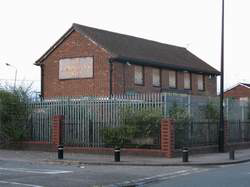Abandoned Communities ..... Central Silvertown
A very major disaster occurred in 1917. One of the chemical factories in Silvertown, Brunner Mond, had been converted to produce TNT for use in World War I. Just before 7 o’clock on the evening of 19 January a massive explosion occurred. It demolished most of the factory, a nearby fire station, a school, St Barnabas’ church, and other local buildings. Lesser damage was caused over a wide area in Silvertown and further afield. The damage came not just from the blast of the explosion but also from the quantity of molten metal and other burning debris thrown into the air. 73 people died as a result of the Silvertown explosion, and over 400 were injured.
In the early 1930s road transport into Silvertown presented major difficulties, particularly at the level crossings where the main road crossed the railway line. At the western entrance to Silvertown the Silvertown Way, Britain’s first flyover, was constructed in 1934. Further east another viaduct was built to avoid one of the level crossings and to provide a by-pass round the centre of Silvertown. This viaduct passed over some of the streets in central Silvertown.
While most of the factories were located south of the North Woolwich Road there was open ground on the north side of the road where housing could be constructed for those employed in the docks and factories. Most of the housing took the form of long terraces of two storey houses, each with a very small back garden and no space at all between the front door and the footpath of the street.
For electoral purposes Silvertown was divided into three polling districts. The area in which we are interested was known as Central Silvertown, or polling district ZB. In 1939 it included two residential streets south of the North Woolwich Road, and a few people lived on Thames Road, which ran through the industrial area, but most of the people of Central Silvertown lived in a block of streets bounded by North Woolwich Road in the south and Oriental Road in the north. From west to east these parallel streets were Gem Street, Charles Street, Arthur Street, Amelia Street, Kempton Street, Emma Street, and Agnes Street.
A lot of houses in central Silvertown contained more than one household. On the 1939 electoral register, at a time when 21 was the minimum age for voting, many addresses had 3 or 4 voters, and a few had 5 or 6. Most working adults would have been employed in the docks or the local factories. Children of school age attended Silvertown Board School between Agnes Street and the eastern end of Oriental Road. If anyone wanted a bath they would have used the public baths in Oriental Road. To attend church they would have gone to St Mark’s church between Oriental Road and the railway line, or to one of the non-conformist churches, including one close to the school. They would have had a choice of public houses, including the Graving Dock Tavern and, in the opposite direction along North Woolwich Road, the Cundy. To read the papers or borrow books they could have gone to the public library opened in 1938 on the corner of Wythes Road in the premises of the Tate Institute.
In the early 1930s road transport into Silvertown presented major difficulties, particularly at the level crossings where the main road crossed the railway line. At the western entrance to Silvertown the Silvertown Way, Britain’s first flyover, was constructed in 1934. Further east another viaduct was built to avoid one of the level crossings and to provide a by-
While most of the factories were located south of the North Woolwich Road there was open ground on the north side of the road where housing could be constructed for those employed in the docks and factories. Most of the housing took the form of long terraces of two storey houses, each with a very small back garden and no space at all between the front door and the footpath of the street.
For electoral purposes Silvertown was divided into three polling districts. The area in which we are interested was known as Central Silvertown, or polling district ZB. In 1939 it included two residential streets south of the North Woolwich Road, and a few people lived on Thames Road, which ran through the industrial area, but most of the people of Central Silvertown lived in a block of streets bounded by North Woolwich Road in the south and Oriental Road in the north. From west to east these parallel streets were Gem Street, Charles Street, Arthur Street, Amelia Street, Kempton Street, Emma Street, and Agnes Street.
A lot of houses in central Silvertown contained more than one household. On the 1939 electoral register, at a time when 21 was the minimum age for voting, many addresses had 3 or 4 voters, and a few had 5 or 6. Most working adults would have been employed in the docks or the local factories. Children of school age attended Silvertown Board School between Agnes Street and the eastern end of Oriental Road. If anyone wanted a bath they would have used the public baths in Oriental Road. To attend church they would have gone to St Mark’s church between Oriental Road and the railway line, or to one of the non-
Two
Silvertown in April 1939
Silvertown Viaduct and some of the houses in Oriental Road
The Graving Dock Tavern
Cundy’s Tavern



